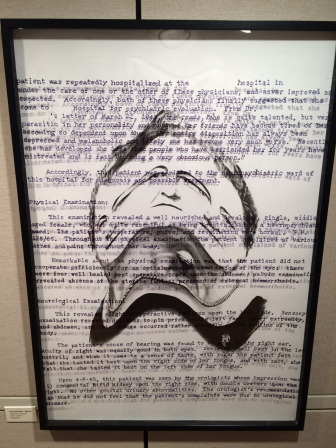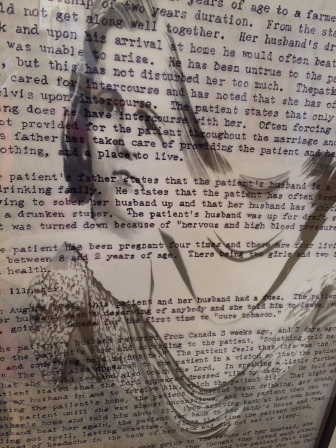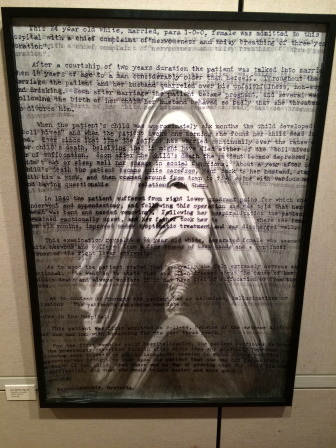The inspiration behind Su Tamsett’s powerful exhibition “Disenfranchised: Hysterics of the 1940s”—making its public debut now and through Dec. 14 in the H. Pelham Curtis Gallery at New Canaan Library—goes back to the native South Carolinian’s childhood observations on how others treated her beloved, late sister Sarah.

From Su Tamsett’s “Disenfranchised: Hysterics of the 1940s,” on exhibition at New Canaan Library through Dec. 14.
A Ridgefield resident and longtime professional architect who took two bachelor’s degrees from the prestigious Rhode Island School of Design, Tamsett during an interview with NewCanaanite.com (excerpts printed below) said that her gifted sister Sarah suffered from a specific type of disability that left the sibling unable to organize herself in space “and also in terms of time sequencing and any kind of paper work.”
Born of a toxemic pregnancy, Sarah’s condition went undiagnosed for many years, and Tamsett recalls seeing her sister misunderstood and largely marginalized for much of the sibling’s life.
Some of that experience was recalled for Tamsett when, in the 1980s, she happened across a recently deceased relative’s medical notes, taken on two dozen women admitted to a highly regarded psychiatric hospital in the 1940s.

From Su Tamsett’s “Disenfranchised: Hysterics of the 1940s,” on exhibition at New Canaan Library through Dec. 14.
Diagnosed as “hysterical” when that word, since abandoned as a medical term, held some real meaning for physicians, the women Tamsett read about would be relegated to institutions—and in many cases, to surgeries such as hysterectomies and certainly to what read today as barbaric, unfathomable treatment plans.
One 24-year-old woman’s case illustrates a typical history of abuse, misplaced blame and failing medical information—in fact, many of the so-called female “illnesses” of the time today are understood as normal, if extreme, cases of PMS, postpartum depression, menopause and other reproductive issues, Tamsett says.
The woman, the medical notes say, on admission “seemed quite nervous and suffered from a fine tremor of both hands” and had difficulty breathing, among other symptoms, was diagnosed with “hysteria.”

Su Tamsett’s “Disenfranchised: Hysterics of the 1940s” is on exhibition at New Canaan Library through Dec. 14.
Married to a much older man who, according to a hospital physician’s interview with the woman, was unfaithful, drank too much and failed to support her, the woman had become pregnant and had a baby. Within weeks of the child’s birth her husband beat her so badly that she threatened to divorce him. One morning when the child was just six months old, the woman found the child dead in bed.
“Soon after the child’s death the patient became depressed, didn’t eat or sleep well nor engage in social functions,” the notes say. “About a year after her child’s death the patient became quite carefree, went back to her husband, stayed with him a week and then roamed around from town going with various men and having questionable (sexual) relations with them.”

From Su Tamsett’s “Disenfranchised: Hysterics of the 1940s,” on exhibition at New Canaan Library through Dec. 14.
She later underwent an appendectomy for pain and afterwards was told that her “womb was bent and needed removing.” She presumably had a hysterectomy, was hospitalized and after she grew upset, was taken by her own father to undergo treatment for six months at yet another institution.
“As to mood the patient stated that she generally felt extremely nervous and emotional,” the notes say. “She went on to state that she often dreamed about the cause of her child’s death and always wonders if it may have died from suffocation or from the hives.”
In this case, the woman underwent psychotherapy and appears to have reacted well (her breathing improved) after learning that she was not responsible for her child’s death.
The woman’s case forms one of the 12 that Tamsett chose to borrow from in “Disenfranchised,” which overlays word-for-word pieces of each patient’s medical record at the hospital (in permanent black marker, on plexi glass) over a distorted pencil drawing of a woman from the era of the 1940s.

From Su Tamsett’s “Disenfranchised: Hysterics of the 1940s,” on exhibition at New Canaan Library through Dec. 14.
We spoke to Tamsett about her purpose and method for the drawings, her models for the women themselves, the project’s history and what it means to her.
Though the work absolutely is best experienced in person, we will make one final note here prior to excerpting from our interview with Tamsett.
In receiving psychotherapy and ultimately coming to an understanding that she was not to blame for her child’s death at six months, the 24-year-old woman, though diagnosed with “hysteria,” received far better advice than did a 23-year-old admitted to the psychiatric hospital.
Plied with “ills and injections” following “nervous spells” that she suffered following the birth of her first child (out of wedlock), the woman was diagnosed as having brought on some of her own symptoms by dressing sloppily, complaining about pain following intercourse, drugging herself in bed and “bellyaching” in such a way that she “might well drive this well-providing husband from her.”
“It was suggested to her that she be out of her bed at 7 a.m., cook her husband three good meals a day, be neat and tidy when he came home from a hard day’s work, keep her complaints to herself, and instead try to sympathize with her husband’s difficulties, and in general be a source of encouragement and happiness to him.”
Here are snippets from our conversation with Tamsett.
New Canaanite: Talk to me about where the idea for this work comes from.
Su Tamsett: This is actually where, I think, this show began. I was thinking and talking earlier that it began in the ‘70s, but it really didn’t. I’ve been thinking over the weekend. I had a sister that was born toxemic and when she was two weeks old, she developed red measles and scarlet fever at the same time, she ran a 105 fever for almost two weeks, with no break. And it left her with a hearing loss and it also left her with an inability to organize herself in space and also in terms of time sequencing and any kind of paper work. So she was never really able to do her checkbook. She learned one route from here to there. And if she was with someone who would deviate from her known traffic pattern even for one block, she would get very anxious. And she could tell that they were going the wrong way. And she had a lot of anxiety about that, because she really knew only one way that she had learned to get places. Once she learned to drive, she could get in the car and go her routes to places, but she never got into the car and went places that she didn’t know. And so from early on, watching her, I saw up until about third or fourth grade that other children noticed she was different, and then she would never be selected for a team, she was always the last one called for games that they used to play like Red Rover. And she was marginalized, though she had an IQ in the 140s and she wrote exquisite, profound poetry. But if you were in the room with her you would forget she was there. She would sit silent and say nothing, then all of a sudden a very astute comment would come out of her. She was undiagnosed for a long time and she didn’t get what she needed. I saw her marginalized. There were people who didn’t understand her. I saw people react to her. They thought she was retarded, which she was not. So I think in seeing that, I have always just had an interest in how people are marginalized.
When did you create these drawings and when did you have this experience where you came across these medical records?
I started at the end of June this year. I came across the records in the 1980s. In the 1970s, I was living in New Jersey and people don’t remember this and it’s very difficult to find on the Web, I think it’s been pretty much erased from the Web, but Geraldo Rivera when he was really a highly respected reporter did an expose on this mental institution in northern New Jersey—it’s now defunct, I won’t say the name of it—but it eventually came out that women were being sexually assaulted by the orderlies, so that was a big scandal. And then as they delved more deeply into the story they realized that many of the women who were there had been wives of corporate executives and they had moved on to wife number two, and the wives were menopausal and ‘hysterical,’ although that was no longer a diagnosis. It was a psychiatric hospital and the doctors were colluding with the husbands. So when I found these records—when this person died, these were records kept during a residency—I knew that some way, somewhere I wanted to do something with them and make a story out of it, but I wasn’t sure what I was going to do, so they just sat there for some time. And then I was actually looking through some materials for a show I was planning to do on my sister and I came across these again and said to myself that I would really like to do a show on this.
How did you settle on this form?
What I wanted was for them to be trapped, which meant I had to do a shadowbox frame. I wanted them trapped in the diagnosis. It was a misdiagnosis, a misunderstanding or a partial understanding of what their issues were and their treatments were off the wall. And I wanted them trapped inside it, which meant I had to do something that was transparent and I even let some of the print just run off the sides of the edges so that they are caught inside this thing. And then in terms of the images, the first thought I had was to go back to magazines from the period, advertising and take images and distort those. And the first thought I had on the distortion was to do a Francis Bacon-esque distortion, which is kind of a combination between what I did and cubism. And then I decided no, I wanted them to be melting and just themselves totally distorted. What I did, and this is how I got the images, I finally decided that I cannot do the other images because I don’t know whether the people in the hospital looked like them and heaven knows what their experiences were. And there were no existing photos of these actual people from the records, and even though I have case numbers on them, those numbers have been scrambled. You don’t want to re-traumatize anyone, though I don’t think any of these women is still living. The youngest one would be in her late-80s now. And I don’t think anyone would ever recognize it as a story of their family, because most people shut these things down. But what I had been doing was going through family photos for my relatives and giving them the images on flash drives. So I had 10,000 photographs and documents, so what I realized is I had portraits of people who were similar ages at that time. So I decided to just take them from my family. All but two of the women living here are no longer living. What I would do is take the portrait and put it on the Xerox bed and as the Xerox ran I would move it around to get the distortion. So I wanted to get that funny mirror kind of thing. I would say from every 20 of those I kept just one.
How many case studies did you read? How many are here?
There are 12 here out of about 24. I used about 50 percent of them. I chose the ones that gave the historical information I wanted. Other ones that I didn’t use were clearly people who were bipolar or schizophrenic and there was no doubt that they had a real mental illness that was biological. But these were the ones tagged with ‘hysterical’ and many of them maybe with a concurrent issue.
Even if the word ‘hysterical’ is not used, how prevalent is this now? You’re a woman who is going to see a physician for something, a GP of some kind of specialist, and you go and maybe you feel a symptom that you are trying to convey has been relegated to something it’s not. How often does that still happen? Also, talk to me about what else you’d want someone to know who is going to come and look at your work.
Something to think about is that this is not that long ago historically that this has happened, and that there are still permutations of this kind of attitude in society. Less and less as we go along, and certainly the Women’s Movement changed a lot of things. I was a woman in a man’s field, and I ran into very little of this. In all the time I worked, I only worked in one office that would be called a ‘boys’ club.’ Other than that I was respected on the site and never discounted, always taken very seriously. But I also know other women who did not have that experience and have been told that they didn’t get a promotion because after all they were a mother and had their own needs or things they’ve said or done meant they were emotionally unstable. It’s still common enough. The thing to take away from this is that it isn’t that long ago. We need women to be proactive when you’re with a doctor. As an advocate for a patient, I know that you have a responsibility to give the doctor a baseline to start with. I think that it has changed for the better. I think having more women physicians in the field has helped, and I think that people are more proactive about becoming part of the equation with the decision-making.